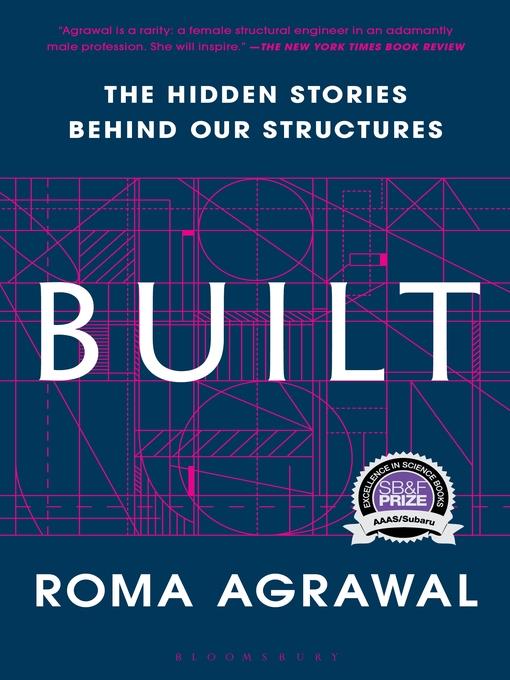
Built
The Hidden Stories Behind Our Structures
کتاب های مرتبط
- اطلاعات
- نقد و بررسی
- دیدگاه کاربران
نقد و بررسی

February 1, 2018
With a lifelong passion for skyscrapers, bridges, and sculptures, structural engineer and first-time author Agrawal here explains engineering concepts in easy-to-understand ways, such as how cathedral ceilings maintain their dome and how stone arches retain their shape. Each of the book's 14 chapters covers a different aspect of structural engineering; black-and-white photographs as well as line drawings of structures allow for a better understanding of engineering concepts. Most importantly, Agrawal describes the work of designing specific kinds of structures, especially the challenge of maintaining efficiency and a budget that is sometimes at odds with sound design. Her breezy, conversational writing style adds a personal touch to what could otherwise be a dry subject. VERDICT A unique addition to public library collections on technology and engineering.--John Napp, Univ. of Toledo
Copyright 2018 Library Journal, LLC Used with permission.

December 18, 2017
Structural engineer Agrawal introduces engineering to the masses in this enthusiastic, easy-to-read primer to her field of work. Organizing her book around the fundamental concepts and building blocks of engineering, Agrawal traces the evolution of construction from simple mud huts to contemporary skyscrapers and demonstrates how basic materials (e.g., clay, metal, rock) are enhanced by modern-day advances in scientific modeling to yield complex new designs. The chapter on force, for instance, looks at the ways structures are built to hold the weight of their occupants and withstand the force of external factors such as wind and earthquakes, and includes examples such as the Taipei 101 skyscraper in Taiwan, which contains a 660-ton pendulum designed to absorb the energy of an earthquake. Throughout the book Agrawal balances stories of historical figures such as Emily Warren Roebling, a field engineer who oversaw the completion of the Brooklyn Bridge in the 1880s, with insights into the developments of today’s architectural wonders. Though the writing is often overly awestruck (as when Agrawal proclaims that buildings “provide the canvas of our existence”), the book successfully communicates the author’s love of engineering and the extraordinary impact of her profession on the everyday lives of people. Illus.

December 15, 2017
Looking at the history of structures through "the eyes of an engineer."For those who wonder why tall skyscrapers don't tip over and long suspension bridges don't collapse, structural engineer Agrawal has some answers. Written in a personable, friendly style featuring the author's own hand-drawn illustrations, the book acts as a guide to "our ever-changing, engineered universe...full of stories and secrets." Agrawal cut her engineering teeth on a footbridge for Northumbria University, assiduously checking and rechecking the forces her bridge would need to withstand; "as engineers," she writes, "we can't afford to make mistakes." In the chapter on "Force," she looks at the effect of gravity on various structures. In 1907, the Quebec Bridge, which spanned the St. Lawrence River, collapsed, killing 75 workers; the engineer underestimated the bridge's weight. Addressing the effects wind or earthquakes can have on buildings, Agrawal explores the Taipei tower in Taiwan, which has a 660-ton steel pendulum near its top, the "heaviest in any skyscraper in the world," which absorbs the tower's movement. In "Fire," she notes that the twin towers' engineers had planned for the effect of a Boeing 707 crashing into the building. Three decades later, when two much larger planes struck them, fires from their fuel loads collapsed the buildings' steel columns. "Clay," "Metal," and "Rock" examine building materials. The author notes how she loves to "stroke" concrete and feel its texture. When Henry Bessemer revolutionized the steel-making industry in the mid-19th century, 200,000 tons per year were produced. By 1898, it was 12 million tons. Without Elisha Otis' elevator, writes Agrawal, buildings would not have been able to go higher and higher: "the equivalent of the entire world's population is moved in an elevator every 72 hours."A delightful introduction to the science of engineering and those key in its development, from Brunelleschi and his Duomo in Florence to Emily Roebling's Brooklyn Bridge to Fazlur Khan's monumental Burj Khalifa in Dubai, the world's tallest building.
COPYRIGHT(2017) Kirkus Reviews, ALL RIGHTS RESERVED.




















![Design Like You Give a Damn [2]](https://dl.bookem.ir/thumbnails/150/ISBN13/9781613122860.jpg)




دیدگاه کاربران